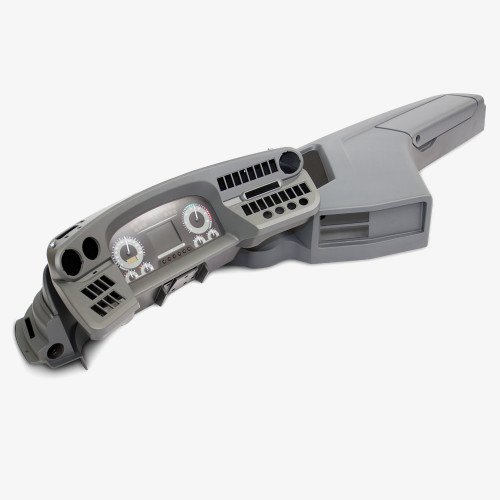
Pre-assembled driver's workstation, made of integral hard foam and compact foam parts using the RIM process (Reaction Injection Molding)
In the RIM (Reaction Injection Molding) process, we process thermoset polyurethane (PUR. In this process, two components are mixed and the resulting compound is injected into an aluminum mold, where it hardens as a result of the crosslinking reaction.
We process the materials Baydur 30, Baydur 60, Baydur 110 and Bayflex. The integral skin foam Baydur 30 is suitable for parts with a film surface, for example made of ABS for robust applications or PVC for molded parts with an automotive look. The parts can be produced practically by backfoaming the film – this procedure is also recommended because polyurethane is not UV-resistant.
Inserts or other adaptation points such as sheet metal angles can be integrated without difficulty. Undercuts can also be easily implemented.
Baydur 60 integral skin foam is used for wall thicknesses ranging from 20 millimeters to an almost unlimited thickness. The compact foam Baydur 110, on the other hand, offers a constant wall thickness of up to 5 millimeters. The Bayflex material is filled with hollow glass spheres and is characterized by maximum flexibility. Bayflex is therefore a high-performance alternative to DCPD. The materials are UL certified. We will be happy to advise you on the selection of the right material for your requirements.
Further processing steps such as priming, painting, printing (for example pad printing or screen printing) are done in-house. There is the possibility for EMC or antibacterial lacquering.
Reinforced Reaction Injection Molding (RRIM)
Like the RIM process, the RRIM process mixes various components and injects them into a mold where they cure to form polyurethane. But unlike the RIM process, a reinforcing material such as fiberglass is added. This increases the durability of components produced. The process is therefore particularly well suited to components that have special robustness requirements (e.g. bumpers).
Structural Reaction Injection Molding (SRIM)
In the SRIM process, a glass fiber mat placed in the mold is surrounded by a reaction compound of rigid polyurethane foam. The reinforcement component is therefore completely enclosed in the PUR compound. This increases the durability of components produced even more than the RRIM process. This manufacturing method is therefore well suited to components with special mechanical property requirements.